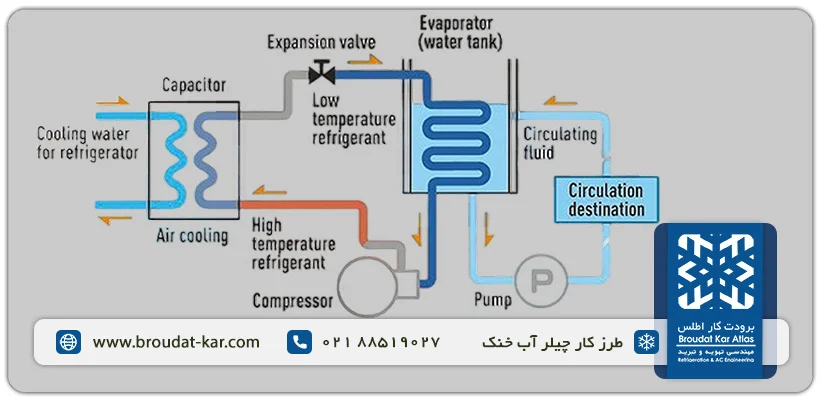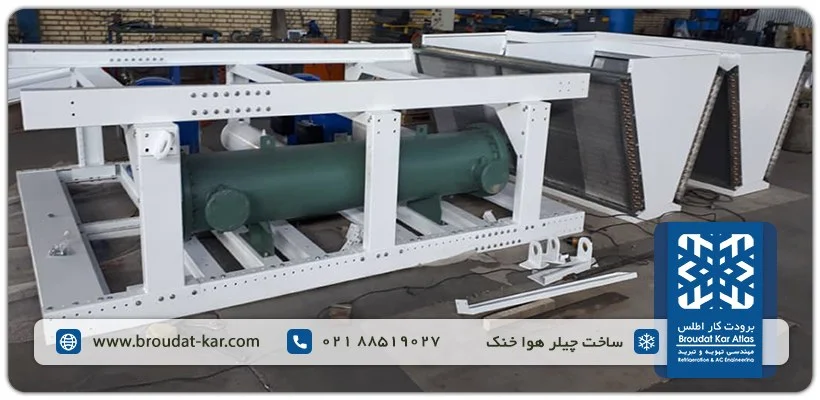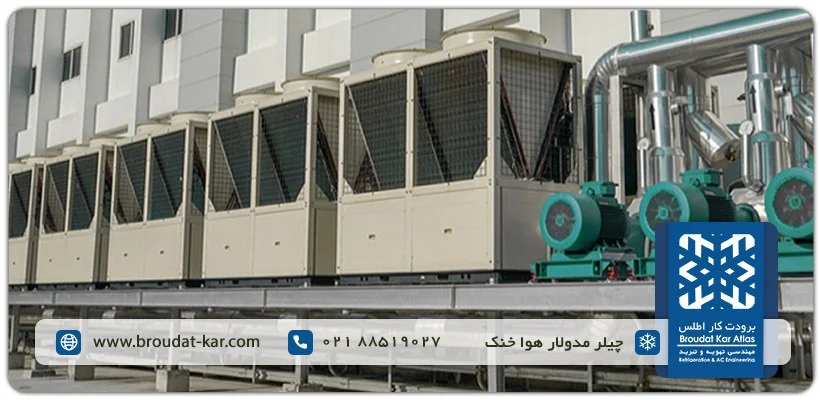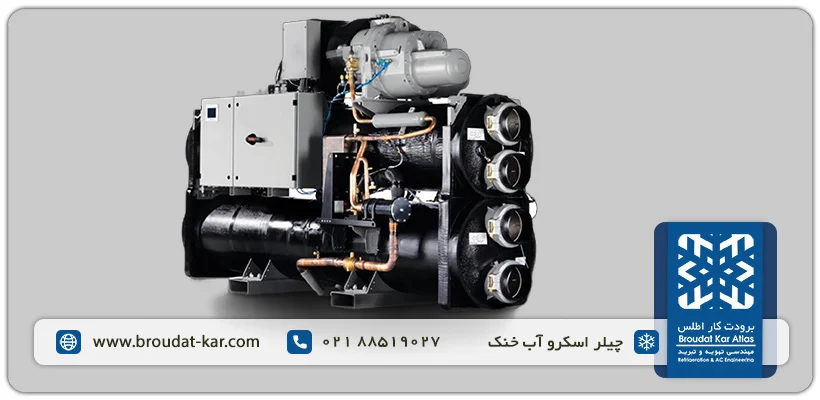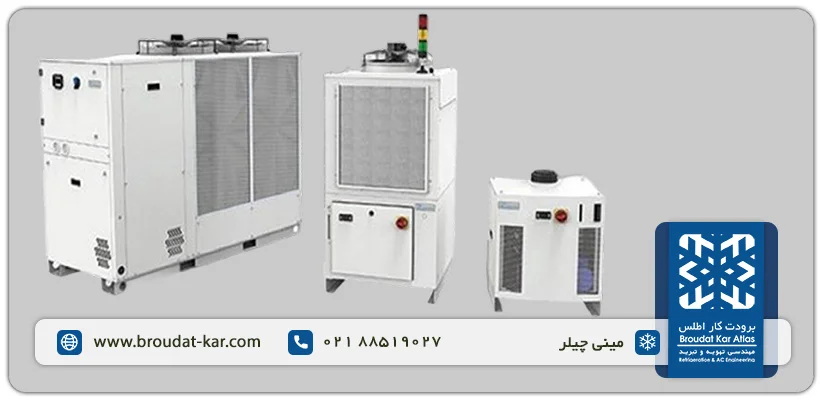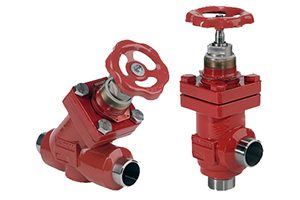What Is a Chiller?
A chiller is a vital piece of industrial equipment used in refrigeration and air conditioning, serving various applications across workshops, industries, commercial spaces, and residences. Its primary function is to cool water to temperatures ranging from +1 to +7 degrees Celsius in a single cycle. Chillers are employed for cooling equipment, processes, and spaces, with their capacity and type selected based on the volume of cold water required.
In essence, a chiller is an industrial device that generates cold water and transfers it to equipment such as air conditioners, fan coils, and cold water heat exchangers. It receives water at a certain temperature and cools it using refrigerants like Freon or ammonia to the desired level, ensuring it remains above freezing point. For applications requiring sub-zero temperatures, ethylene glycol is used instead of water, as it has a freezing point of about -12 degrees Celsius.
A chiller is a device that regulates temperature by circulating a flowing liquid, typically water. The temperature of this liquid is controlled through the refrigeration cycle.
Main Components of a Chiller
The chiller comprises several essential components, each serving a specific function crucial to the cooling process. Understanding these components is vital for grasping the chiller’s operation. Here are the main components:
- Compressor: The compressor is the heart of the chiller. It compresses the refrigerant, transforming it into a high-temperature, high-pressure gas. Compressors come in various types, such as screw or piston, which significantly influence the chiller’s efficiency and cost.
- Condenser: Responsible for condensing the refrigerant from a gas to a liquid, the condenser also cools it down (subcooling). Condensers can be water-cooled or air-cooled, with different types affecting the overall chiller classification.
- Expansion Valve: This modular valve rapidly decreases the pressure of the liquefied refrigerant from the condenser to the evaporator, transforming it back into a gas. This process cools the water or fluid within the evaporator. Expansion valves come in electronic and thermostatic types, with electronic valves offering higher accuracy at a higher price point.
- Evaporator: The evaporator facilitates the transfer of heat from water to refrigerant. As the refrigerant evaporates within the evaporator, it absorbs heat from the water, thus reducing its temperature. Evaporators come in plate and shell and tube types, with plate types typically offering higher efficiency.
How Does a Chiller Work?
Chillers operate by utilizing the refrigeration cycle to cool the water required by various equipment. In essence, the chiller functions by using a refrigerant to transfer heat from water or ethylene glycol to the surrounding environment. The process begins as the low-pressure refrigerant gas enters the compressor, where its pressure and temperature are significantly increased. Subsequently, the refrigerant travels to the condenser, where it releases heat at constant pressure and undergoes a phase change from gas to liquid. Next, the liquid refrigerant enters the evaporator through the expansion valve.
the refrigerant drops during evaporation, it absorbs heat from the water, effectively cooling it. Finally, the refrigerant, now carrying the absorbed heat, returns to the compressor to begin the refrigeration cycle anew. Through this process, the water is thoroughly cooled, typically reaching temperatures as low as +4 degrees Celsius, before being circulated for use, while the heated refrigerant continues its cycle within the chiller.
Chiller Technical Specifications
The technical specifications of chillers vary depending on factors such as type, application, and model. However, when selecting a chiller, it’s essential to consider certain key specifications to ensure it meets your requirements effectively. Here are some important technical specifications to consider:
- Cooling Capacity: This indicates the chiller’s ability to remove heat from the fluid and is typically measured in kilowatts, BTU/hr, or tons of refrigeration.
- Cooling Method: Determine whether the chiller is designed for cool water or air-cooled operation based on your specific needs.
- Minimum Water Temperature: Consider the lowest temperature the chiller can achieve to ensure it meets your cooling requirements.
- Electrical Panel Type: Evaluate the automation capabilities of the chiller’s electrical panel to meet operational needs.
- Expansion Valve Type: Choose between thermostatic or electronic expansion valves based on performance and control requirements.
- Dimensions and Installation: Assess the size of the chiller and whether it’s suitable for indoor or outdoor installation based on available space and environmental conditions.
- Quality of Components: Consider the brand and quality of parts used in the chiller to ensure reliability and longevity.
- Compressor Type: Evaluate the compressor type (scroll, piston, or screw) and brand to ensure compatibility with your application and performance requirements.
- Manufacturing Standards: Verify that the chiller complies with relevant manufacturing standards to ensure safety and quality.
- Price and Terms: Consider the overall cost of the chiller, including warranty, terms of sale, and after-sales service, to make an informed decision.
Ultimately, the technical specifications of the chiller should align with your specific needs and operational constraints. For instance, if your application requires fluid temperatures below +1 degree Celsius, ethylene glycol may be necessary instead of water. Additionally, if water availability is limited, an air-cooled chiller may be preferable.
Chiller Usage Types
Chillers serve various purposes across different sectors within the air conditioning industry. Broadly speaking, chiller usage types can be categorized into the following two categories:
- Air Conditioning Systems: Chillers are extensively used in air conditioning systems for commercial, industrial, and residential purposes. They play a crucial role in regulating indoor temperature by cooling water or another intermediate fluid, which is then circulated through the building to remove heat and maintain comfortable conditions.
- Industrial Applications: Chillers find widespread use in industrial settings for various cooling applications. They are employed in manufacturing processes, food and beverage production, pharmaceuticals, plastics processing, and more. In industrial applications, chillers are utilized to cool equipment, machinery, or products to specific temperatures required for production processes.
Overall, regardless of their specific structures, all chillers share the common task of reducing and controlling the temperature of water or another intermediate fluid, such as ethylene glycol. They provide efficient cooling solutions wherever cold water or chilled fluid is needed, catering to diverse requirements across different sectors and applications.
Utilizing Chillers in Air Conditioning Systems
In air conditioning systems, chillers play a pivotal role in regulating temperatures. They facilitate the cooling process by circulating water or a cooling fluid like ethylene glycol through heat exchangers such as fan coils or air conditioners. This cooled liquid then absorbs heat from the air in the designated space, effectively reducing its temperature. Subsequently, the now-warmed liquid returns to the chiller to undergo the cooling process anew. Chillers designed for air conditioning applications typically offer a cooling capacity ranging from approximately 50 kW to 21 MW, with notable examples produced by companies like YORK.
Utilizing Chillers Across Industrial Applications
In industrial settings, chillers find widespread application across various sectors and processes. They are integral for cooling equipment, machinery, and even laboratory setups. Industries benefiting from chiller usage encompass a wide spectrum, including casting, food processing, pharmaceuticals, plastics and molding, paper manufacturing, cement production, vacuum systems, X-ray apparatus, semiconductor fabrication, and power generation turbines.
Industrial chillers may be configured centrally, serving multiple cooling requirements simultaneously. Alternatively, they can be employed individually for distinct cooling needs. Each approach offers its unique set of advantages and drawbacks, depending on factors such as operational requirements, scalability, and resource allocation.
Types of chillers, comparison of types of chillers
There are different categories for chillers, but in general, chillers can be divided into two general categories: compression chillers and absorption chillers. Each of these two categories will be divided into different subcategories. Of course, some people consider another category called mini chiller for all kinds of chillers. But this classification is not correct; Because mini chillers are low capacity chillers that are used for light residential applications and are usually compression type.
A piston or compression chiller uses a compressor and refrigerant compression to cool air conditioning devices. But in absorption chillers, there is no compressor and the water in these chillers is cooled using a generator. In this section, we introduce the types of absorption chillers and compression chillers and compare them.
Types of Chillers
Compressor Type
- Scroll Chiller: Utilizes scroll compressors, ideal for residential or small industrial settings due to their compact size and lower capacity.
- Screw Chiller: Features high efficiency and capacity ranging from 60 to 500 tons of refrigeration, suitable for high-end industrial and residential applications with variable capacity control.
- Piston or Reciprocating Chiller: Utilizes piston compressors with capacities ranging from 5 to 40 tons of refrigeration, suitable for achieving desired capacity by using multiple compressors.
- Centrifugal Chiller: Known for its high efficiency, low energy consumption, and long lifespan, primarily used in specialized projects due to its relatively higher cost.
Condenser Type
- Water-Cooled Chillers: Utilize a cooling tower to dissipate heat from the refrigerant by circulating water, offering higher efficiency but requiring water for operation.
- Air-Cooled Chillers: Installed in open environments, utilize a coil and fin condenser to dissipate heat directly to the surrounding air, suitable for humid areas and environments with simple piping requirements.
Refrigerant Type
Refrigerants can be from the Freon family (R-22, R-134A, R-404A) or ammonia (R717). Freon refrigerants are commonly used in mini chillers and those with smaller capacities for residential air conditioning. Ammonia refrigerants offer better thermodynamic properties, reducing both initial purchase cost and electricity consumption, making them ideal for high-capacity applications.
Types of Absorption Chillers
Absorption chillers utilize thermal energy (hot water or steam) to produce cold and are categorized based on performance and energy consumption:
- Performance-based Classification: Includes single-effect and double-effect chillers.
- Energy Consumption-based Classification: Includes direct flame and indirect flame chillers, with direct flame chillers operating directly with the flame for cooling.
Absorption chillers have fewer moving parts compared to compression chillers, resulting in lower maintenance and repair requirements. They are virtually vibration-free and produce less noise. However, they require a constant supply of hot water or steam from a boiler for operation.
Comparison of Absorption Chiller and Compression Chiller
When deciding between absorption and compression chillers, it’s essential to compare their features and suitability for specific applications. Here’s a comparison between the two types:
Coefficient of Performance (COP): Compression chillers typically have a COP ranging from 3.5 to 6, depending on the compressor type. In contrast, absorption chillers have a COP of around 1.4 in similar conditions, indicating lower efficiency.
Weight and Dimensions: Absorption chillers are larger and heavier compared to compression chillers of the same capacity, occupying more space.
Chiller Price: Absorption chillers are generally more expensive than compression chillers due to their larger size and specialized requirements.
Energy Consumption: Absorption chillers tend to consume more energy and water compared to compression chillers.
Noise Production: Absorption chillers produce less noise during operation than compression chillers.
In summary, absorption chillers may be suitable for specific applications such as hospitals where steam boilers are available and noise reduction is critical. However, due to their lower efficiency, higher cost, and larger dimensions, compression chillers are often the more technically and financially viable option for around 90% of applications.
Chiller Price Factors and Considerations
Determining the price of a chiller involves several factors, and each model may vary in cost. Here are some considerations to keep in mind when estimating the price of a chiller:
- Type of Chiller: Whether it’s a condensation or absorption chiller will significantly impact the price.
- Chiller Capacity: The cooling capacity of the chiller, measured in tons or kilowatts, plays a key role in determining its price.
- Type of Compressor: Different types of compressors, such as scroll, screw, or piston, can affect the cost of the chiller.
- Condenser Type: The type of condenser, whether air-cooled or water-cooled, will influence the price.
- Quality of Parts: The quality and brand of components used in the chiller can affect its price and overall performance.
- Manufacturer Brand: Well-known brands may command higher prices due to their reputation and reliability.
- Energy Consumption: Chiller models with higher energy efficiency ratings may come at a premium price but can offer long-term savings on operating costs.
- Device Efficiency: The overall efficiency and performance of the chiller can impact its price.
- Dimensions and Weight: Larger and heavier chillers may be more expensive due to their size and installation requirements.
Considering these factors before making a purchase is crucial. Consulting with experts in the field can help you choose the best chiller model that meets your specific needs and budget. Feel free to contact us for a free consultation to explore your options further.
Key Considerations When Purchasing an Industrial Chiller
When investing in an industrial chiller, ensuring quality and affordability is paramount. Here are crucial points to consider to make an informed purchase decision:
- Assess Thermal Load: Determine the thermal load of your industrial system to understand the cooling requirements. This helps in selecting a chiller that can efficiently meet the temperature reduction needs of your environment.
- Choose the Right Type: Review the different types of chillers available and match their features with your specific requirements. For harsh environments, a compression air-conditioning chiller might be suitable, while a mini chiller could suffice for a small workshop.
- Consider Size and Weight: Evaluate the dimensions and weight of the chiller against the available installation space. Oversized chillers waste energy and occupy unnecessary space, while undersized ones may fail to adequately cool the environment.
- Review Performance Curves: Pay close attention to the performance curves of potential chillers. Factors such as cold water source temperature and ambient air temperature impact performance and efficiency.
- Determine Capacity: Accurately calculate the required chiller capacity based on usage, thermal load, geographical and climatic conditions, and heat-generating equipment in the environment. Consulting with experts can help ensure the right capacity selection.
- Assess Number of Chillers Needed: For large projects or expanding environments, multiple chillers of varying capacities might be necessary. Evaluate whether additional chillers are needed upfront or in the future to meet growing demands.
- Evaluate Efficiency: Look for chillers with high Energy Efficiency Ratio (EER) ratings, indicating better energy performance. Higher EER values signify more efficient cooling relative to energy consumption.
- Choose a Reliable Brand and Seller: Opt for reputable sellers offering trusted chiller brands and comprehensive after-sales service and warranty. Seek recommendations from previous customers and industry experts to ensure reliability and satisfaction.
By carefully considering these factors and seeking expert guidance, you can select the most suitable and efficient industrial chiller for your specific needs.
Chiller Services: Comprehensive Solutions by Atlas Refrigeration Company
Atlas Refrigeration Company offers a wide range of chiller services to cater to diverse applications. Our services encompass chiller design, manufacturing, installation, as well as warranty and after-sales support.
Upon receiving your requirements, our expert team provides tailored advice and proceeds with chiller design and capacity measurement. Once the design is finalized and agreed upon, the chiller construction process begins. Depending on the type and capacity, the construction and delivery process typically ranges from 30 to 90 days. During this period, buyers are informed about necessary prerequisites for chiller installation, such as electricity supply and foundation execution.
After the chiller is prepared and transported to the installation site, our technical team ensures seamless installation, testing, and commissioning. Once installation is completed to satisfaction, the chiller is handed over to the buyer, marking the commencement of the warranty period and after-sales service.
Specialized Chiller Sales: Quality Products at Competitive Prices
Atlas Refrigeration Company prides itself on being a leader in chiller design and specialized sales. With a proven track record of excellence, we strive to meet the diverse needs of our customers efficiently.
Our commitment to offering high-quality chillers at competitive prices enables you to procure all types of chillers and refrigeration equipment with confidence. Our sales experts are available to provide detailed information and assist with the ordering process for various refrigeration products.
In Conclusion
We aimed to provide comprehensive information about chillers and our range of services in this article. As a key player in the industry, Atlas Refrigeration Company stands ready to meet your chiller needs, offering services including design, installation, repairs, and more. We hope this content has been informative for you. Please feel free to reach out with any further inquiries or feedback regarding chillers.
Related posts
Chiller
What is Ducted Split? A ducted split system, also known as a duct split, is an HVAC configuration that
What is Air Conditioning? Air conditioning encompasses the regulation of temperature, humidity, and air quality within indoor spaces, aiming to



